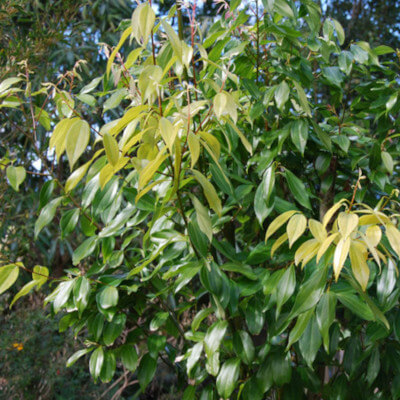
The Chinese cinnamon tree, or Cinnamomum cassia, is an iconic species native to the subtropical regions of Asia, particularly southern China and Vietnam. A member of the Lauraceae family, this tree can grow to a height of 10 to 15 metres when fully mature. Its most distinctive feature is its aromatic bark, which has been valued for thousands of years for both its culinary and medicinal properties.
In its natural habitat, Chinese cinnamon thrives in the dense, humid forests of tropical and subtropical zones. Its evergreen foliage, made up of glossy, leathery oval leaves, adds a refreshing touch to the botanical garden of Au Bois Vert in Ivato, near Antananarivo. During the warm season, typically between May and July, the tree produces clusters of small, delicately scented yellowish flowers, which are later followed by oval-shaped black berries.
Grown primarily for its prized bark, Chinese cinnamon is highly sought after in global cuisine as well as in traditional medicine. Beyond its culinary and therapeutic uses, it holds ecological and cultural significance for our lodge, where visitors to our hotel can observe it in a carefully designed setting that respects the local ecosystem.
As an essential feature of exotic gardens, this plant thrives in tropical climates. It has a long lifespan and can start producing cinnamon from the age of seven, continuing to yield this precious spice for several decades.
Plant use
Chinese cinnamon holds a central place in many cultures due to its diverse applications. Its bark, known for its sweet and spicy flavour, is a key ingredient in cooking, whether to enhance savoury dishes or desserts. It is commonly used in curries, chai teas, and pastries, offering a unique culinary experience to visitors at our restaurant in Antananarivo. In traditional medicine, Cinnamomum cassia has been used for centuries for its therapeutic properties. Its bark contains active compounds such as cinnamaldehyde and eugenol, which are known for their anti-inflammatory and antioxidant benefits. It also helps to stimulate blood circulation, improve digestion, and strengthen the immune system. Beyond its culinary and medicinal uses, the essential oil extracted from Chinese cinnamon is highly valued in aromatherapy for its warm fragrance and relaxing effects. It is also widely used in skincare and the production of natural cosmetic products. Visitors to the Au Bois Vert botanical garden will have the opportunity to learn more about this remarkable plant while enjoying a unique natural setting in Ivato. Chinese cinnamon perfectly illustrates how both local and exotic biodiversity can enrich the experience of our guests.
Key information
| Common name | Chinese cinnamon |
| Scientific name | Cinnamomum cassia |
| Origin | South China, Vietnam |
| Natural habitat | Subtropical rainforests |
| Life cycle | Perennial |
| Flowering period | May to July |


